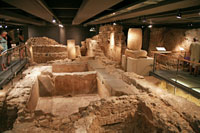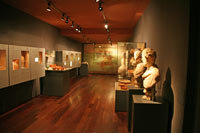The museum is housed in a 15th century Gothic palace which is just inside a portion of the old Roman city wall that we’ve been walking by for the past week or so. Supposedly, during excavation work necessary to build new foundations for the palace, remains of the old Roman city were uncovered.
 From 1930 until 1960 a large area was excavated, and to better preserve the remains, it was decided to move Barcelona's city museum to this site.
From 1930 until 1960 a large area was excavated, and to better preserve the remains, it was decided to move Barcelona's city museum to this site. The museum's exhibitions start on the ground floor where several small rooms show the prehistory of Barcelona.
We then took an elevator to an underground level where you can see remains of the old Roman city of Barcino. How old?? Well, we are told it was founded around 10 BC by emperor Augustus. That’s pretty old!!
 The underground section is huge and takes about an hour to wander from start to finish. They have set up walkways above the ruins, and I am told that what I was looking at included the remains of a laundry and drying workshop from the 2nd century, a salted fish and garum factory (check out that link! Garum was a popular fermented fish sauce, to me it sounds like the most disgusting food ever.) and also a wine making facility (probably built to wash down the Garum made next door!!
The underground section is huge and takes about an hour to wander from start to finish. They have set up walkways above the ruins, and I am told that what I was looking at included the remains of a laundry and drying workshop from the 2nd century, a salted fish and garum factory (check out that link! Garum was a popular fermented fish sauce, to me it sounds like the most disgusting food ever.) and also a wine making facility (probably built to wash down the Garum made next door!!There are also ruins from a later period, including a church from the Visigoth period (6th century) and the episcopal complex, built between the 4th and 7th century AD.
Now, how they know that one pile of old rocks was a Laundromat, and another was a
wine making factory is beyond me. But, overall if you believe what you are being told as you walk through the displays, you can not fail to be impressed by the construction techniques that enabled these structures to last (even partially) for so long.
The Romans did a very impressive job building strong, functional structures. They primarily worked with stone. Square stones, rectangular stones, cylindrical stones, etc. They built walls, support structures, buildings, roads, aquaducts, and drainage systems. All from these very basic building blocks.
Imagine what they could have done with Legos!!!!








No comments:
Post a Comment